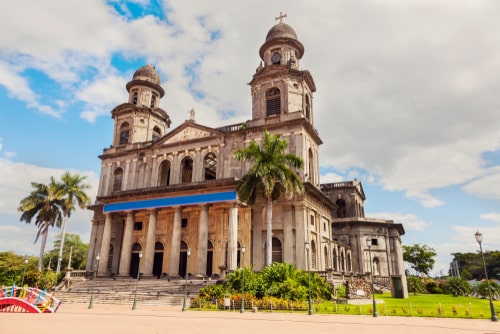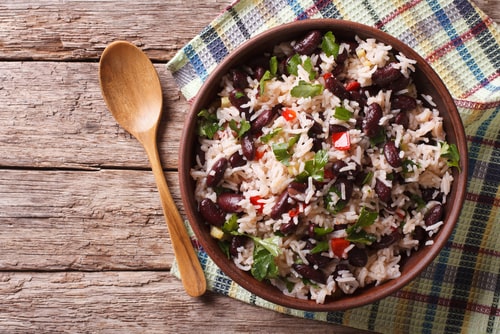Last updated on October 29th, 2022
About Nicaragua’s capital city, Managua
26. Nicaragua has a population of around six million people and almost one million of them live in its capital city of Managua.
27. Managua lies on a geological fault line that seismologists predict will cause the city to experience a severe earthquake every 50 years or less.
28. A 1972 earthquake killed more than 19,120 Managuans and destroyed 90 percent of the city’s downtown area.
29. The eleven year long Contra war of the 1980s further wrecked the city. Reconstruction began in earnest after the 1990 presidential election.
30. Category Five Hurricane Mitch struck in 1998, killing over 3,000 and displacing over two million people. Learn more about hurricanes with National Hurricane Center.

31. Managua replaced Leon as the capital in 1858 because Leon and Granada couldn’t stop bickering viciously about which of their cities should be the country’s capital. Neutral Managua was chosen instead.
32. Tap water in Managua is considered safe to drink. Outside of the capital, bottled water is advised.
33. The city is served by Managua International Airport. The country has three other airports as well.
34. Taxis are readily available but be sure to get one with red license plates with legible numbers.
35. Los Angeles and Miami are international sister cities of Managua.
Also read: Interesting facts about Paraguay
Facts about Nicaragua’s culture and cuisine
36. Nicaraguans refer to themselves as Nicas.
37. The official language of Nicaragua is Spanish but the native dialects and English Creole are also spoken.
38. Nicaragua celebrates religious freedom by adopting no national religion; it is a secular state. However, 85 percent of the population is Roman Catholic.
39. The Nicaraguan culture has been influenced from its Spanish, British, African and Caribbean roots.
40. Though it is the largest country in Central American, Nicaragua has the lowest density of population.
41. The Nicaraguan people are fairly young: 36 percent of the population is under 14 years of age. Their median age is 26.5 years.
42. Most people are mestizos (Spanish and natives combined). The British brought African slaves to Nicaragua to work on plantations in the 1600s. Many Nicaraguans are their descendants as well.
43. The Nicaraguans are a strong and resilient people who place great value on family and family life. They have shown a great deal of perseverance through times of great adversity and have tremendous national pride.

44. The national dish of Nicaragua is “Gallo pinto” (spotted rooster): a combination of white rice and small cooked red beans, often eaten for breakfast.
45. Corn is the Nicaraguan’s staple food. Nacatamales are corn flour dumplings filled with veggies and cooked wrapped inside plantain leaves. Corn is also used to make many different traditional drinks.
46. Nicaragua is the birthplace of Ruben Dario, a notable poet who was extremely influential in the 1900s Latin America poetry community and is world renown.
47. Bianca Jagger, Rolling Stone singer Mick Jagger’s ex-wife, is a Nicaraguan native who is an environmental and social activist and represents Amnesty International.
48. Nicaragua is famous for folk dances, especially its “Palo de Mayo”. Music combines guitar and wooden marimba or flutes and drums. Dancing is a part of all holidays.
49. Traditional arts include ceramics and earthenware still made in pre-Colombian designs, silver working and gold filigree, wood carving and embroidery.
50. Independence Day is celebrated throughout the month of September and not just for a day. The Festival of Santa Domingo is in August and the Alegria por la Vida (Happiness for Life) Festival takes place in March.
You may like: Interesting facts about Bolivia
Nicaragua facts for kids

51. Lake Nicaragua is home to the only freshwater sharks in the world, the bull sharks. They swim up the Rip San Juan from the Atlantic Ocean and once in the lake, adapt themselves to live in fresh water. Now rarely found in the lake, none have been spotted in years.
52. The Bosawas Biosphere Reserves protects 12 different kinds of venomous snakes in its cloud forest.
53. Baseball is the national sport and many professional baseball leagues exist. They enjoy both playing and watching baseball. Soccer (football) comes in second.
54. The Managuans don’t name their streets. How do they deliver mail? Your address is given by whatever major landmarks you happen to live near (such as three blocks north of the Flower Corner). Sometimes the names of the landmarks change, so it can get very confusing.
55. The country of Nicaragua is about the same size as the state of New York.
Nicaragua is a beautiful tropical country with amazing landscapes and friendly people. Its warm climate and biodiversity are enough to lure visitors from all over the world.
About the Flag of Nicaragua

1. Design and Symbolism
The flag of Nicaragua shows the pride of a Central American republic. It has three horizontal bands: blue at the edges and white at the middle. These represent the country as a land between oceans: the Pacific and the Atlantic.
The center features the national coat of arms of Nicaragua. This emblem is an upright triangle showing a rainbow over five volcanoes while a red Phrygian cap hovers above. Around it is a golden text that reads, “Republica de Nicaragua” and “America Central.”
The triangle represents equality among all people, while the rainbow signifies peace over the land. The red cap symbolizes liberty. It became a popular motif after its association with the French Revolution. Lastly, the volcanoes represent the Central American countries and their brotherhood.
2. Adoption
Nicaragua adopted the flag on September 4, 1908. However, this only became official on August 27, 1971, along with a redesign of the coat of arms.
3. Technical Details
The flag uses a ratio of 3:5. No part of the coat of arms lies outside the central white band, including the text.
4. History
Central America was a Spanish colony from the 1500s to the early 1800s. In 1821, the region declared independence from Spain. The empire did not resist this declaration, resulting in a bloodless transition of power to the locals.
However, regional powers refused to accept the new federal government. Law and order broke down as revolts spread. Some territories voted for annexation by Mexico, while others maintained their independence and banded together to form a federal republic. Members included Nicaragua, Guatemala, El Salvador, Honduras, Costa Rica, and Los Altos. The flag of Central America was a horizontal triband with blue edges and a coat of arms at the center.
In 1838, the union collapsed, and Nicaragua became an independent republic. Rivalries, civil wars, and military adventurers made the country unstable, as reflected in the multiple flag redesigns in the following decades.
The late 1800s saw multiple attempts to reunite the federal republic. In 1856, they formed a military coalition to repel an unauthorized US takeover by William Walker. In 1896, Honduras, Nicaragua, and El Salvador created the Greater Republic of Central America. It only lasted for two years.
In 1908, Nicaragua adopted the old Central American federation flag as its national banner. They modified the coat of arms to make it an appropriate emblem for the independent republic. Gone are the ribbon, wreath, and gold border. The new version contained the water symbol inside the triangle. The text is also specific to Nicaragua.
5. Flag Facts
The flag of Nicaragua is one of a few national flags that have a splash of purple, as seen in the rainbow of the coat of arms. The others are from Dominica and El Salvador.
The Cordillera de Apaneca of El Salvador inspired the five volcanoes in the flag. This landscape is visible from the city of Sonsonate, the former capital of the Federal Republic of Central America.
Nicaragua – country at a glance
| Independence | 15 September 1821 (from Spain) |
|---|---|
| Capital City | Managua (12°9′N 86°16′W) |
| Largest City | Managua (12°9′N 86°16′W) |
| Area | total: 130,370 sq km land: 119,990 sq km water: 10,380 sq km |
| Area - comparative | slightly larger than Pennsylvania; slightly smaller than New York state |
| Agricultural land | 42.2% |
| Population | 6,676,948 (2024 est.) |
| Demonym | Nicaraguan |
| Literacy | 82.6% |
| National anthem | "Salve a ti, Nicaragua" (Hail to Thee, Nicaragua) |
| National symbol | turquoise-browed motmot (bird) |
| National colors | blue, white |
| Official Language | Spanish |
| Government type | Presidential Republic |
| Co-President | Daniel Ortega Rosario Murillo |
| Borders | Costa Rica and Honduras |
| Currency | Córdoba (NIO) |
| Religion | Roman Catholicism |
| Life expectancy at birth | 74.78 Years (2024 est.) (The greatest fully authenticated age to which any human has ever lived is 122 years 164 days by Jeanne Louise Calment from France.) |
| Industries | food processing, chemicals, machinery and metal products, knit and woven apparel, petroleum refining and distribution, beverages, footwear, wood, electric wire harness manufacturing, mining |
| Climate | tropical in lowlands, cooler in highlands |
| Terrain | extensive Atlantic coastal plains rising to central interior mountains; narrow Pacific coastal plain interrupted by volcanoes |
| Mean elevation | 298 m |
| Lowest point | Pacific Ocean 0 m |
| Highest point | Mogoton 2,085 m |
| Coastline | 910 km |
| Natural resources | gold, silver, copper, tungsten, lead, zinc, timber, fish |
| Birth rate | 16.4 births/1,000 population (2024 est.) |
| Death rate | 5.1 deaths/1,000 population (2024 est.) |
| Sex ratio | 0.96 male(s)/female (2024 est.) |
| Exports | $8.25 billion (2023 est.) coffee, beef, gold, sugar, peanuts, shrimp and lobster, tobacco, cigars, automobile wiring harnesses, textiles, apparel, cotton |
| Imports | $10.517 billion (2023 est.) consumer goods, machinery and equipment, raw materials, petroleum products |
| GDP - per capita (PPP) | $7,500 (2023 est.) |
| Time Zone | CST (UTC−6) |
| Internet country code | .ni |
| Calling Code | +505 |
| Drives on the | Right |
| Table last updated | February 21, 2025 |
